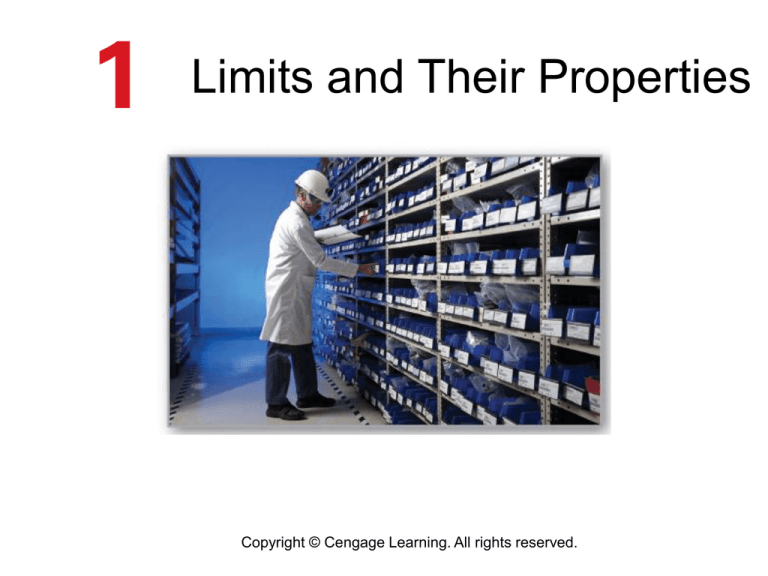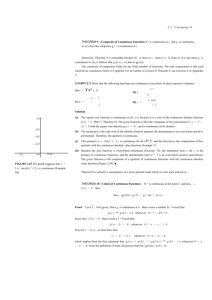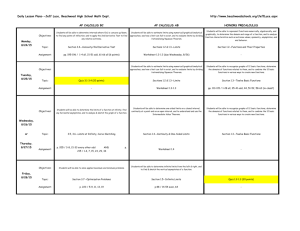
Limits and Their Properties
Copyright © Cengage Learning. All rights reserved.
1.3
Evaluating Limits Analytically
Copyright © Cengage Learning. All rights reserved.
Objectives
Evaluate a limit using properties of limits.
Develop and use a strategy for finding limits.
Evaluate a limit using the dividing out technique.
Evaluate a limit using the rationalizing technique.
Evaluate a limit using the Squeeze Theorem.
3
Properties of Limits
4
Properties of Limits
The limit of f(x) as x approaches c does not depend on the
value of f at x = c. It may happen, however, that the limit is
precisely f(c).
In such cases, the limit can be evaluated by direct
substitution. That is,
Such well-behaved functions are continuous at c.
5
Properties of Limits
6
Example 1 – Evaluating Basic Limits
7
Properties of Limits
8
Example 2 – The Limit of a Polynomial
Solution:
9
Properties of Limits
The limit (as x → 2 ) of the polynomial function
p(x) = 4x2 + 3 is simply the value of p at x = 2.
This direct substitution property is valid for all polynomial
and rational functions with nonzero denominators.
10
Properties of Limits
11
Example 3 – The Limit of a Rational Function
Find the limit:
Solution:
Because the denominator is not 0 when x = 1, you can
apply Theorem 1.3 to obtain
12
Properties of Limits
Polynomial functions and rational functions are two of the
three basic types of algebraic functions. The next theorem
deals with the limit of the third type of algebraic function—
one that involves a radical.
13
Properties of Limits
The next theorem greatly expands your ability to evaluate
limits because it shows how to analyze the limit of a
composite function.
14
Example 4(a) – The Limit of a Composite Function
Find the limit.
Solution:
a. Because
you can conclude that
15
Example 4(b) – The Limit of a Composite Function
Because
you can conclude that
16
Properties of Limits
You have seen that the limits of many algebraic functions
can be evaluated by direct substitution. The six basic
trigonometric functions also exhibit this desirable quality, as
shown in the next theorem.
17
Example 5 – Limits of Trigonometric Functions
18
A Strategy for Finding Limits
19
A Strategy for Finding Limits
You studied several types of functions whose limits can be
evaluated by direct substitution. This knowledge, together
with the next theorem, can be used to develop a strategy for
finding limits.
20
Example 6 – Finding the Limit of a Function
Find the limit:
Solution:
Let f(x) = (x3 – 1)/(x – 1)
By factoring and dividing out like factors, you can rewrite f
as
21
Example 6 – Solution
cont’d
So, for all x-values other than x = 1, the functions f and g
agree, as shown in Figure 1.17
f and g agree at all but one point
Figure 1.17
22
Example 6 – Solution
Because
cont’d
exists, you can apply Theorem 1.7 to
conclude that f and g have the same limit at x = 1.
23
A Strategy for Finding Limits
24
Dividing Out and Rationalizing
Techniques
25
Dividing Out Technique
One procedure for finding a limit analytically is the dividing
out technique. This technique involves diving out common
factors.
26
Example 7 – Dividing Out Technique
Find the limit:
Solution:
Although you are taking the limit of a rational function, you
cannot apply Theorem 1.3 because the limit of the
denominator is 0.
27
Example 7 – Solution
cont’d
Because the limit of the numerator is also 0, the numerator
and denominator have a common factor of (x + 3).
So, for all x ≠ –3, you can divide out this factor to obtain
Using Theorem 1.7, it follows that
28
Example 7 – Solution
cont’d
This result is shown graphically in Figure 1.18.
Note that the graph of the function f coincides with the
graph of the function g(x) = x – 2, except that the graph of f
has a gap at the point (–3, –5).
Figure 1.18
29
Rationalizing Technique
Another way to find a limit analytically is the rationalizing
technique, which involves rationalizing the numerator of a
fractional expression.
Recall that rationalizing the numerator means multiplying the
numerator and denominator by the conjugate of the numerator.
For instance, to rationalize the numerator of
multiply the numerator and denominator by the conjugate of
which is
30
Example 8 – Rationalizing Technique
Find the limit:
Solution:
By direct substitution, you obtain the indeterminate form
0/0.
31
Example 8 – Solution
cont’d
In this case, you can rewrite the fraction by rationalizing the
numerator.
32
Example 8 – Solution
cont’d
Now, using Theorem 1.7, you can evaluate the limit
as shown.
33
Example 8 – Solution
cont’d
A table or a graph can reinforce your conclusion that the
limit is 1/2 . (See Figure 1.20.)
Figure 1.20
34
Example 8 – Solution
cont’d
35
The Squeeze Theorem
36
The Squeeze Theorem
The next theorem concerns the limit of a function that is
squeezed between two other functions, each of which has
the same limit at a given x-value, as shown in Figure 1.21
Figure 1.21
37
The Squeeze Theorem
The Squeeze Theorem is also called the Sandwich
Theorem or the Pinching Theorem.
38
The Squeeze Theorem
39
Example 9 – A Limit Involving a Trigonometric Function
Find the limit:
Solution:
Direct substitution yields the indeterminate form 0/0.
To solve this problem, you can write tan x as (sin x)/(cos x)
and obtain
40
Example 9 – Solution
cont’d
Now, because
you can obtain
41
Example 9 – Solution
cont’d
(See Figure 1.23.)
Figure 1.23
42









